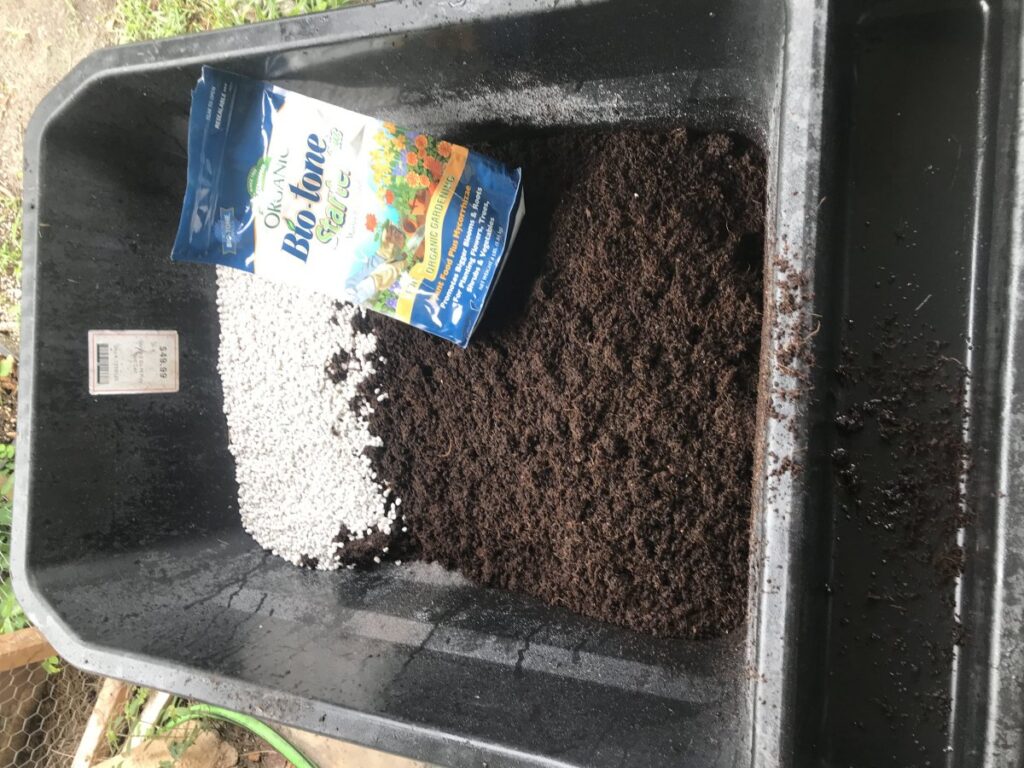
Have you ever thought about making your own potting soil? That stuff at the big box stores is expensive, and you may not even know what’s in it.
Lately, there is a lot of controversy surrounding the use of peat in soil mixes. This is especially true in the UK, where there are so many gardeners and so little peatland. They’ll even be outlawing it by 2024.
Peat isn’t sustainable — not really. It takes thousands of years to replace. Here in the U.S., we get most of our peat from Canada, where we can assume that there is much more to be had. But it doesn’t grow back any faster in Canada.
While it seems disasterous that gardeners might someday run out of peatmoss, the really concern is that peat bogs sequester more of the earth’s carbon than any other type of vegetation. Every time a peat bog is drained and backhoe rips up a layer of peat, tonnes of carbon are released into the atmosphere.
And it’s not a trivial amount. According to the International Union for Conservation of Nature (IUCN), peat bog harvesting results in the release of about 1.3 gigatonnes of CO2 every year. This equals approximately 5.6 percent of global CO2 emissions overall. That’s just flabbergasting.
Save Money AND the Planet by Making Your Own Potting Soil
With the UK banning peat in potting soil, manufacturers are rushing to create replacement mixes. You’ll find many brands overseas, but here in the U.S., they’re few and far between. They’re also expensive.
It may seem overwhelming to make your own potting soil, but it’s so worthwhile once you get a system in place. I can blame soil-blocking and a busted air conditioner for my foray into homemade potting soil.
I like the idea of using soil blocks. Mainly, because my seed trays were falling apart. I literally was using duct tape to hold them together. Soil blocking requires a special seed starting mix, so I was already armed with most of the ingredients for potting soil.
One of the key ingredients for potting soil is compost. That’s one that isn’t so quick to come up with — not homemade compost, anyway. I’ve been focusing a lot on soil health more than production this last year. So, I have finally managed to produce a somewhat adequate supply of homemade compost. (I also had a fresh bag of Black Kow to fall back on, just in case.)

Soil Blocking Mix
For soil blocking (more on that another time), I started with a basic mix of:
4 parts coconut coir
2 parts perlite
1 part compost
1 cup Epsoma Bio-Tone Starter Plus organic plant food per cubic yard of mix
Soil blocking relies heavily on the fibrous nature of the coir (or peat) to maintain integrity, hence the high percentage in this mix. I went with the Epsoma Bio-Tone because I didn’t want to invest heavily in bags and bags of blood meal, green sand, kelp meal, etc., that most soil block mixes prescribe.
- FOR EVERYTHING YOU PLANT: Use Bio-tone Starter Plus fertilizer when…
- Made of 100% natural coco fiber
- Perlite is a unique volcanic mineral which expands from four to twenty…
I don’t really have room to store them, and I didn’t want to carry them all, either.
Seed Starting Mix
In seed trays, you don’t need such a heavy hand with the coconut coir. I modified the soil blocking mix to use as a seed starter:
4 parts coconut coir
3 parts perlite
2 parts compost
1 cup Epsoma Bio-Tone Starter Plus organic plant food per cubic yard of mix

Upgrade to Potting Soil
The best part of making your own potting soil is that once you have your seed-starter mix, you don’t have to start from scratch. Just take your seed starting mix and add more compost and Epsoma.
4 parts seed starting mix
1 part compost
1 cup Epsoma per cubic yard of potting soil mix
These formulas all work for Making Your Own Potting Soil for vegetable plants, flowers, foliage houseplants, and landscaping plants. The mix provides an excellent structure, microbiology, and some nutrition.
You can add liquid food for specific stages of growth without worrying about burning your plants.

Making Your Own Potting Soil is a Form of Freedom
One of my biggest gardening goals in the last two years is being able to break ties with the big box stores for most of my garden needs. While we have lived in Florida for several decades, the idea of “buying dirt” strikes something in my Midwestern (and frugal) soul.
I like to source as much of my garden inputs as I possibly can. (Just wait, I’ll be re-learning how to fish sometime this year, because when you live within walking distance of the Gulf, you have no excuse for buying fish emulsion).
Making my own potting soil feels like I’m that much closer to self-sufficiency.
Last update on 2025-06-20 / Affiliate links / Images from Amazon Product Advertising API
This product presentation was made with AAWP plugin.






